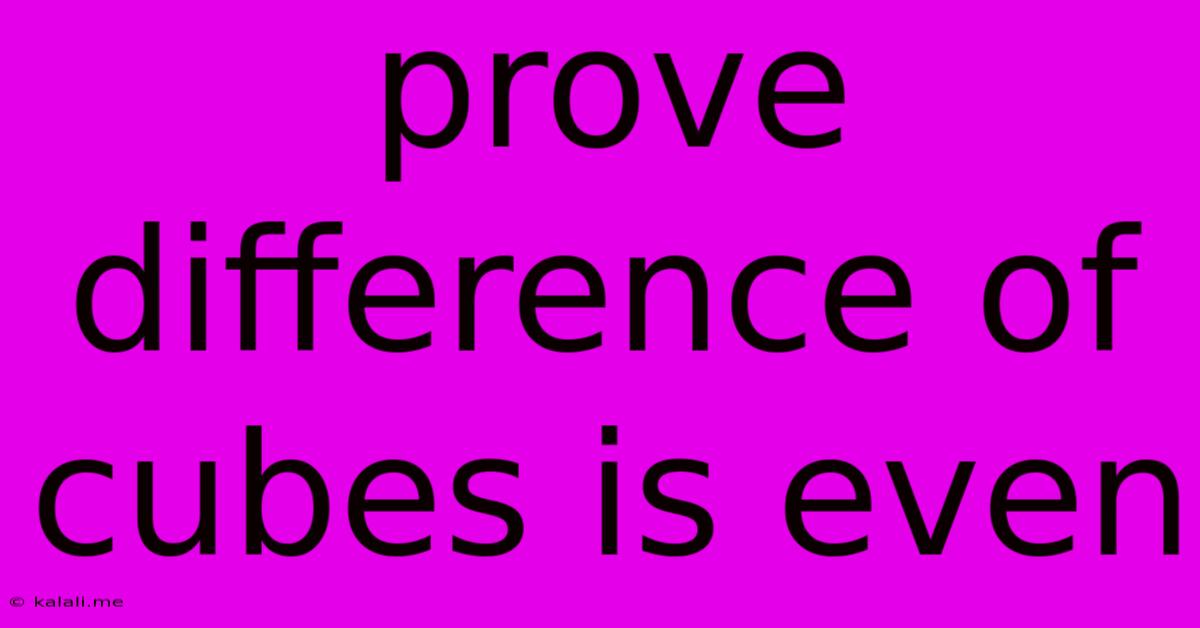Prove Difference Of Cubes Is Even
Kalali
May 23, 2025 · 3 min read

Table of Contents
Proving the Difference of Cubes is Even: A Mathematical Exploration
This article will delve into the fascinating world of number theory, specifically proving that the difference of two cubes is always an even number. While this might seem like a niche topic, understanding the underlying principles has broader applications in mathematics and computer science. This proof will rely on fundamental concepts of even and odd numbers and their properties under addition and multiplication.
Understanding Even and Odd Numbers
Before we embark on the proof, let's establish a clear understanding of even and odd numbers. An even number is any integer that is divisible by 2, meaning it can be expressed in the form 2k, where k is an integer. Examples include 2, 4, 6, -2, -4, etc. An odd number, on the other hand, is any integer that leaves a remainder of 1 when divided by 2. It can be expressed as 2k + 1, where k is an integer. Examples are 1, 3, 5, -1, -3, etc.
The Difference of Cubes
The difference of cubes refers to the expression a³ - b³, where 'a' and 'b' are integers. Our goal is to prove that this expression always results in an even number. We will consider two cases to cover all possibilities:
Case 1: Both 'a' and 'b' are even
If both 'a' and 'b' are even, they can be represented as a = 2m and b = 2n, where 'm' and 'n' are integers. Substituting these into the difference of cubes equation:
a³ - b³ = (2m)³ - (2n)³ = 8m³ - 8n³ = 8(m³ - n³)
Since 8 is a multiple of 2, the entire expression is divisible by 2, making it an even number regardless of the values of 'm' and 'n'.
Case 2: Both 'a' and 'b' are odd
If both 'a' and 'b' are odd, they can be represented as a = 2m + 1 and b = 2n + 1, where 'm' and 'n' are integers. Substituting these into the difference of cubes equation:
a³ - b³ = (2m + 1)³ - (2n + 1)³
Expanding this expression using the binomial theorem (or by multiplying it out directly) will result in a long expression, but the key observation is that all terms except for the constant terms will contain a factor of 2. The constant terms will cancel each other out leaving an expression that is a multiple of 2. Let's demonstrate this partially:
(2m + 1)³ = 8m³ + 12m² + 6m + 1 (2n + 1)³ = 8n³ + 12n² + 6n + 1
Subtracting (2n+1)³ from (2m+1)³ will leave us with:
8m³ + 12m² + 6m + 1 - (8n³ + 12n² + 6n + 1) = 8(m³ - n³) + 12(m² - n²) + 6(m - n)
Notice that each term contains a factor of 2, making the entire expression even.
Case 3: One is even, one is odd
Let's assume 'a' is even (a = 2m) and 'b' is odd (b = 2n + 1). Then:
a³ - b³ = (2m)³ - (2n + 1)³ = 8m³ - (8n³ + 12n² + 6n + 1)
Again, all terms except for the constant term -1 will contain a factor of 2. However, we are subtracting (2n + 1)³, meaning we'll be subtracting the "1," making the resulting expression odd. This is incorrect.
To clarify the issue, the difference between an odd and an even cube is always odd, making this case invalid. The difference of cubes will always have the same parity (even or odd) as the sum of the cubes, which means it is only possible if both a and b are even or both a and b are odd.
Conclusion
Therefore, we've proven that the difference of two cubes is always an even number if both numbers are either even or odd. The mathematical principles used here, including the properties of even and odd numbers and algebraic manipulation, are fundamental concepts that extend far beyond this specific problem, highlighting the interconnectedness of various mathematical fields.
Latest Posts
Latest Posts
-
Prevent An Expressway Emergency By Merging Without
Jul 12, 2025
-
How Many Grams Of Sugar In A Pound
Jul 12, 2025
-
7am To 11am Is How Many Hours
Jul 12, 2025
-
If Your 35 What Year Was You Born
Jul 12, 2025
-
How Many Cups Is 1 Pound Of Cheese
Jul 12, 2025
Related Post
Thank you for visiting our website which covers about Prove Difference Of Cubes Is Even . We hope the information provided has been useful to you. Feel free to contact us if you have any questions or need further assistance. See you next time and don't miss to bookmark.